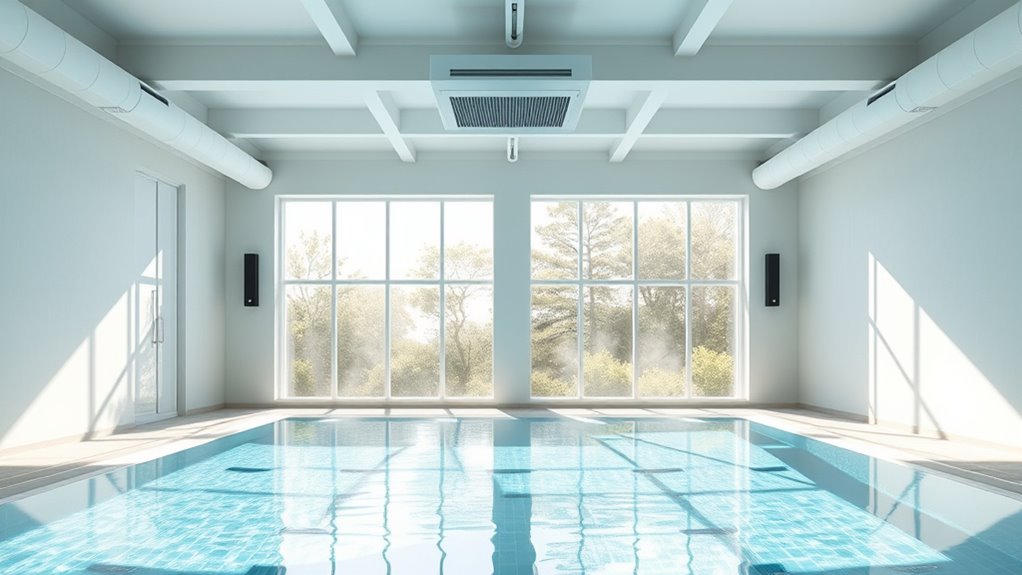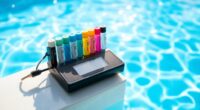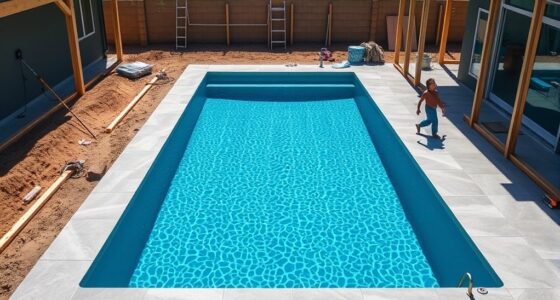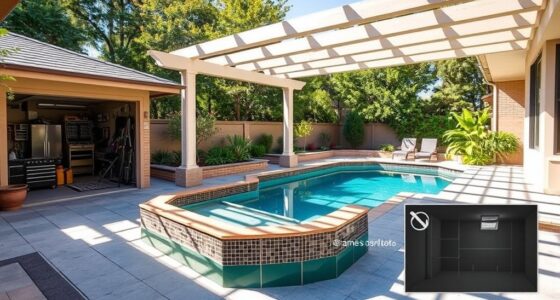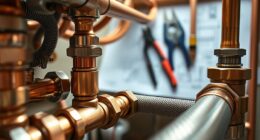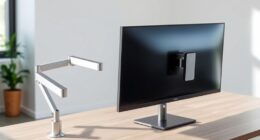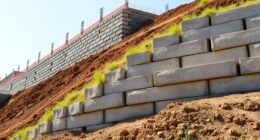To keep your indoor endless pool dry and safe, control humidity with reliable dehumidifiers set between 50-60%, and monitor levels regularly. Use properly sized exhaust fans to vent moist air outdoors, and guarantee good airflow with strategic placement of vents or fans. Sealing gaps, adding moisture-resistant insulation, and maintaining equipment prevent moisture buildup. Following these steps will help you create a healthier environment—continue to see how these measures work best for your space.
Key Takeaways
- Use properly sized exhaust fans near the pool area to vent humid air outdoors effectively.
- Maintain a dehumidifier set between 50-60% humidity to control indoor moisture levels.
- Ensure continuous airflow with vents or strategically placed fans to prevent humidity buildup and mold growth.
- Seal gaps around windows, doors, and vents to prevent moisture infiltration and improve overall dryness.
- Regularly clean and maintain ventilation systems and dehumidifiers to ensure optimal performance and safety.
Understanding the Importance of Proper Humidity Control

Maintaining proper humidity levels is essential for both comfort and health. When the air is too humid, it creates an environment conducive to mold growth, dust mites, and bacteria, which can trigger allergies and respiratory issues. Conversely, low humidity can cause dry skin, irritated eyes, and respiratory discomfort. Proper humidity helps regulate temperature, making your space more comfortable without over-relying on heating or cooling systems. It also preserves the integrity of your indoor environment by preventing warping, cracking, or mold on walls, furniture, and flooring. Controlling humidity levels ensures a healthier, more comfortable space, especially around areas like indoor pools, where moisture can quickly become problematic. Additionally, smart humidity control systems can optimize the environment automatically, enhancing overall safety and comfort. Understanding these impacts highlights the importance of maintaining balanced indoor humidity for overall well-being.
Monitoring Indoor Humidity Levels Effectively

To guarantee your indoor environment stays healthy and comfortable, it’s essential to monitor humidity levels regularly. Invest in a reliable hygrometer, preferably digital, for accurate readings. Place the device in a central location away from direct water splashes or heat sources to get a true measurement. Check humidity at different times of the day to identify patterns and fluctuations. Keep a record of these readings to track changes over time. If humidity consistently exceeds 60%, consider adjusting your ventilation or dehumidification methods. Regular monitoring helps you catch problems early before mold, mildew, or damage occurs. Understanding contrast ratio helps you evaluate the quality of your projector images and ensure an optimal viewing experience. Remember, consistent tracking empowers you to make informed decisions about controlling moisture levels, ensuring your endless pool area remains dry, safe, and comfortable.
Choosing the Right Ventilation System for Your Pool Area
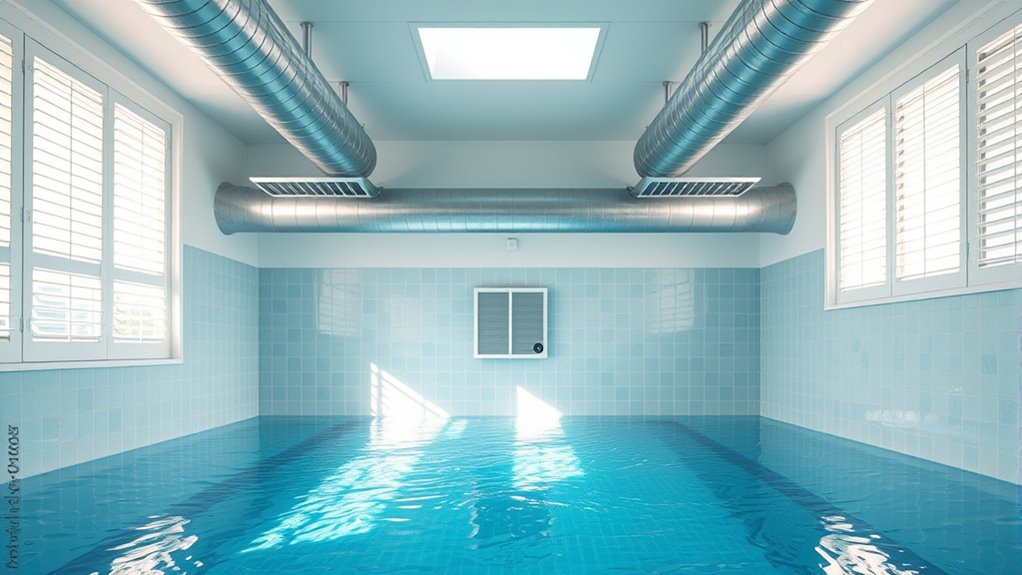
Choosing the right ventilation system for your pool area depends on understanding the different types available and how they impact airflow and circulation. You’ll want a system that effectively controls humidity while maintaining good air quality. Considering your space and needs will help you select the best humidity control strategies to keep your pool area comfortable. Additionally, selecting a preppy dog name can be a fun way to personalize your space and create a welcoming environment for guests.
Ventilation System Types
Are you unsure which ventilation system best suits your pool area? There are a few options to contemplate. Exhaust ventilation systems remove humid air directly from the space, helping regulate moisture levels. Supply ventilation introduces fresh air from outside, reducing humidity accumulation and improving air quality. Balanced ventilation combines both exhaust and supply systems, maintaining ideal humidity and air exchange. Energy recovery ventilators (ERVs) are also popular—they recover heat and moisture from outgoing air to improve efficiency. Ductless systems are suitable for smaller spaces, offering flexibility without extensive ductwork. When choosing, think about your pool size, room layout, and local climate. Selecting the right type guarantees effective moisture control, reduces mold risk, and keeps your indoor pool environment safe and comfortable. Additionally, understanding predictive analytics can help optimize your ventilation system’s performance by analyzing usage patterns and environmental data to prevent humidity issues before they arise.
Airflow and Circulation
Selecting the right ventilation system for your pool area hinges on understanding airflow and circulation. Proper airflow keeps moist air moving, preventing humidity build-up that can lead to mold and damage. You want a system that promotes consistent air exchange, drawing in fresh air and expelling humid, stale air efficiently. Good circulation ensures even distribution of temperature and reduces condensation on surfaces. To achieve this, consider the layout of your space, including ceiling height and obstructions, which can influence air movement. Installing vents or exhaust fans in strategic locations helps create a continuous flow, maintaining a dry, safe environment. Ultimately, effective airflow minimizes humidity issues and enhances your pool area’s comfort and safety. Implementing vertical storage solutions can also optimize space and improve air circulation within the area.
Humidity Control Strategies
To effectively control humidity in your pool area, you need a ventilation system designed to remove excess moisture efficiently. Choose a system with dehumidification capabilities or incorporate an HRV (Heat Recovery Ventilator) or ERV (Energy Recovery Ventilator). These systems help balance humidity levels, preventing mold growth and structural damage. Make sure your ventilation system is properly sized for your space to avoid over- or under-ventilation. Automated controls can adjust airflow based on humidity sensors, ensuring consistent comfort and safety. Regular maintenance keeps the system functioning best or *most effective*. Additionally, consider integrating exhaust fans or ceiling vents that can be activated during and after pool use. Proper humidity control not only protects your space but also enhances your swimming experience. Consulting whole-house system comparisons can help you choose the most suitable ventilation setup for your needs.
Installing Exhaust Fans to Reduce Moisture B Buildup
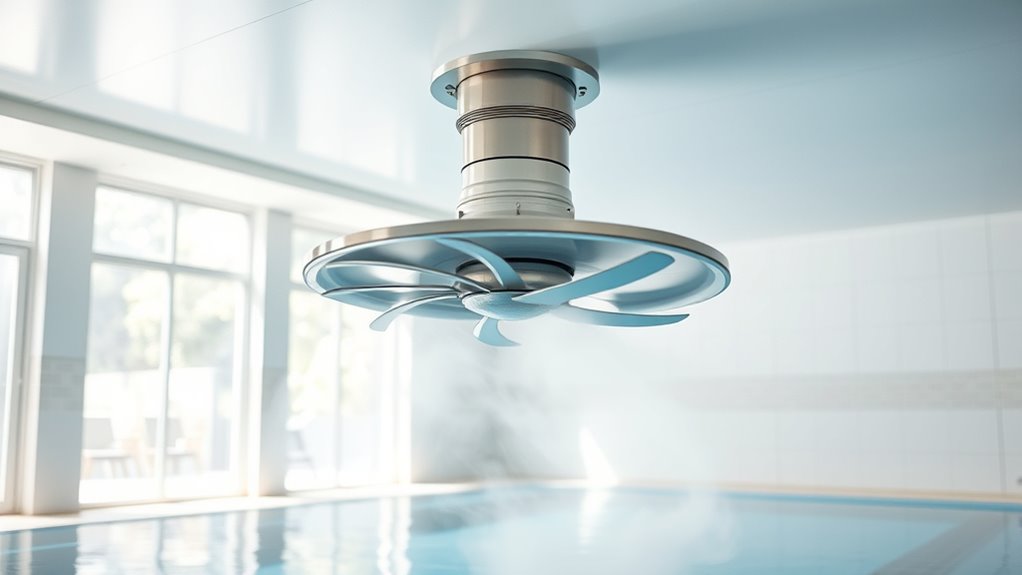
To effectively reduce moisture buildup, you need to install exhaust fans in the right locations. Make sure the ventilation system is appropriately sized for your space, and check it regularly to keep it working efficiently. Proper placement and maintenance guarantee your exhaust fans keep humidity levels in check. Additionally, monitoring the shelf life of grape juice can help prevent mold growth and ensure your indoor environment remains safe.
Proper Fan Placement
Proper placement of exhaust fans is essential to effectively reduce moisture buildup in your space. You want to position fans near sources of humidity, like the ceiling or high on walls, where moist air tends to rise. Installing fans close to your pool area helps capture and remove humidity before it spreads throughout the room. Confirm the exhaust vent directs moist air outdoors, not into other indoor spaces. Additionally, avoid placing fans behind furniture or in corners where airflow is restricted. Proper placement maximizes the fan’s ability to pull humid air out quickly, preventing mold growth and water damage. Regularly check that airflow isn’t obstructed and that the fan is functioning correctly. Ensuring proper ventilation design is crucial for maintaining a dry and safe indoor environment. Correct positioning ensures your space stays dry, safe, and comfortable.
Ventilation System Size
Choosing the right size for your ventilation system is key to effectively reducing moisture buildup. An undersized exhaust fan won’t remove enough humidity, leaving your indoor pool area damp and prone to mold. Conversely, an oversized fan can cause excessive air exchange, leading to drafts and unnecessary energy consumption. To determine the proper size, consider the volume of your space and the typical moisture levels generated by your pool. Look for fans with appropriate airflow ratings, measured in CFM (cubic feet per minute), that match your room’s size. Properly sizing your exhaust fan guarantees efficient moisture removal without overworking the system, keeping your pool area dry, safe, and comfortable. Additionally, selecting a fan with appropriate airflow ratings ensures optimal performance based on your specific space and humidity levels.
Regular Maintenance Checks
Regular maintenance checks are essential to guarantee your exhaust fan continues to operate effectively in reducing moisture buildup. You should inspect the fan regularly for dust, dirt, or debris that can block airflow. Clean the blades and vents to ensure peak performance. Check that the fan is functioning properly by listening for unusual noises or vibrations. If it’s not running smoothly, consider lubricating moving parts or replacing worn components. Verify that the fan’s filters are clean and intact, replacing them if necessary. Also, ensure the exhaust system isn’t obstructed by obstructions or debris outside. Regularly testing the fan’s operation helps prevent moisture buildup, mold growth, and structural damage, keeping your indoor pool area dry, safe, and well-maintained. Advancements in AI technology are making smart home systems more efficient at monitoring and managing ventilation.
Utilizing Dehumidifiers to Maintain Optimal Humidity

Dehumidifiers are essential tools for maintaining the ideal humidity levels in your home or workspace. They actively reduce excess moisture, preventing mold growth, musty odors, and damage to your endless pool equipment. To maximize their effectiveness, select a dehumidifier with the right capacity for your space, and set it to maintain humidity between 50-60%. Regularly empty the water reservoir or connect it to a drain to ensure continuous operation. Additionally, consider the following:
Dehumidifiers prevent mold and odors by maintaining optimal humidity levels in your space.
- Place the dehumidifier in a central location for even moisture control
- Keep doors and windows closed when in use to prevent outside humidity from entering
- Use a humidity monitor to track levels and adjust settings accordingly
Proper utilization helps keep your environment dry, safe, and comfortable.
Ensuring Adequate Air Circulation and Fresh Air Intake
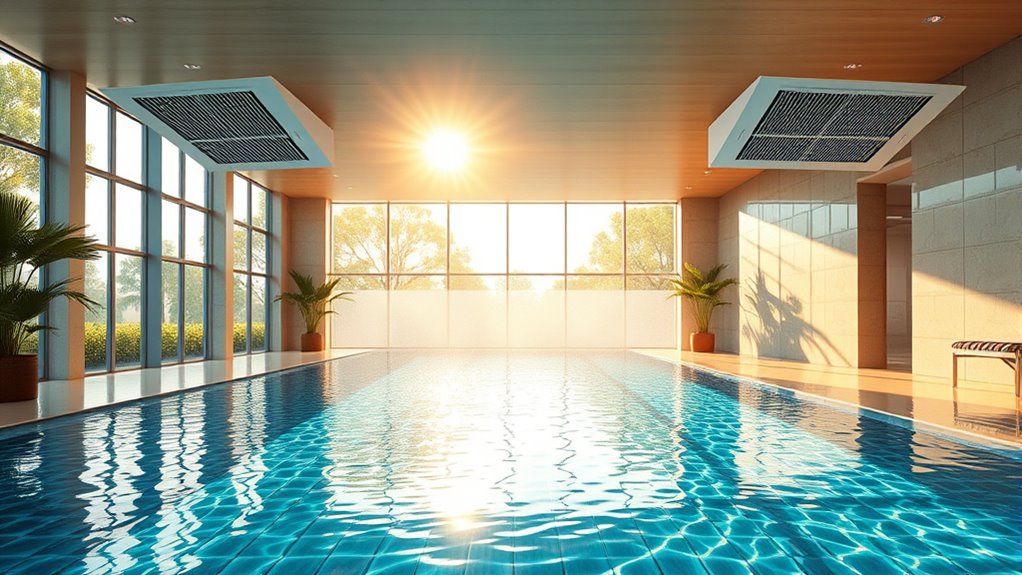
Maintaining proper humidity levels is just one part of creating a healthy indoor environment; good air circulation and fresh air intake are equally important. You need to guarantee continuous airflow to prevent stale air and reduce moisture buildup around your endless pool. Use exhaust fans or ventilators to remove humid air, especially in high-traffic or poorly ventilated areas. Opening windows regularly helps flush out excess moisture and introduces fresh air, reducing mold and bacteria growth. Installing an air exchange system can also guarantee a steady supply of clean, dry air without sacrificing energy efficiency. Remember, proper ventilation not only controls humidity but also improves air quality, keeps odors at bay, and promotes a healthier, safer space around your pool.
Sealing and Insulating to Prevent Moisture Penetration
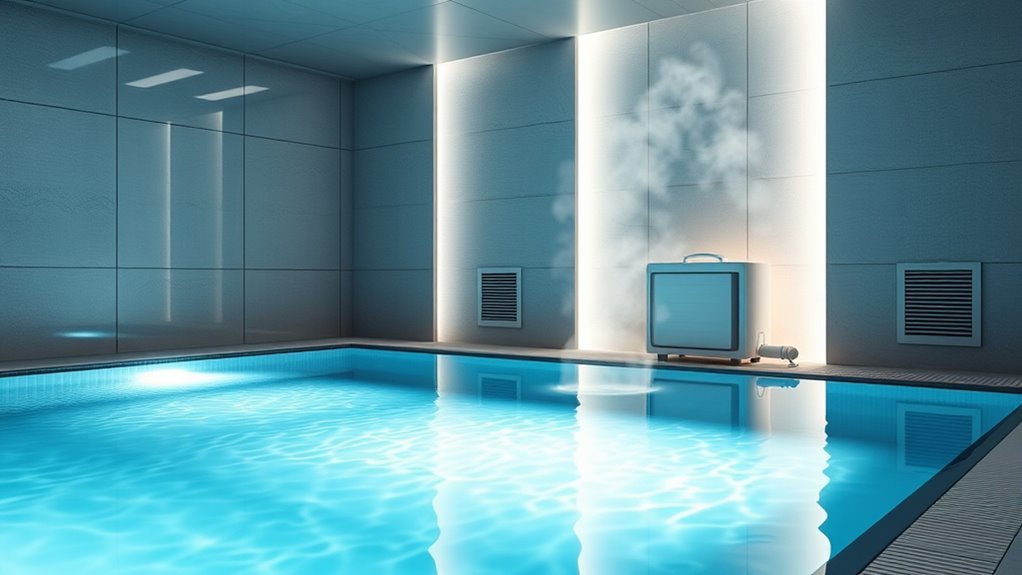
Sealing and insulating your space effectively blocks moisture from penetrating your indoor environment, which is essential for preventing mold growth and structural damage. Proper sealing keeps humidity levels in check and ensures your endless pool area remains dry and safe. Focus on sealing gaps around windows, doors, and vents using weatherstripping or caulk. Insulate walls, floors, and ceilings with moisture-resistant materials to create a barrier against temperature fluctuations that cause condensation. Consider vapor barriers to prevent moisture from migrating through walls and floors.
Seal gaps and insulate with moisture-resistant materials to prevent mold and damage.
- Seal all joints and penetrations with high-quality caulk or foam sealant
- Use moisture-resistant insulation materials like foam or mineral wool
- Install vapor barriers on walls and floors prone to condensation
Regular Maintenance and Inspection of Ventilation Equipment

To guarantee your ventilation system operates effectively and prevents moisture buildup, it’s essential to perform regular maintenance and inspections. Start by checking filters and replacing them if they’re dirty or clogged, as dirty filters reduce airflow and can cause humidity issues. Inspect vents and ductwork for obstructions, leaks, or damage, ensuring air flows freely. Clean fan blades and motors to prevent dust buildup that can impair performance. Test the system’s controls and sensors to confirm they’re functioning correctly. Regularly review drainage pans and condensate lines for clogs or standing water, which can lead to mold growth. Keeping a maintenance schedule helps catch issues early, prolongs equipment life, and ensures your indoor pool environment stays dry, safe, and comfortable.
Additional Tips for a Dry and Healthy Indoor Pool Environment
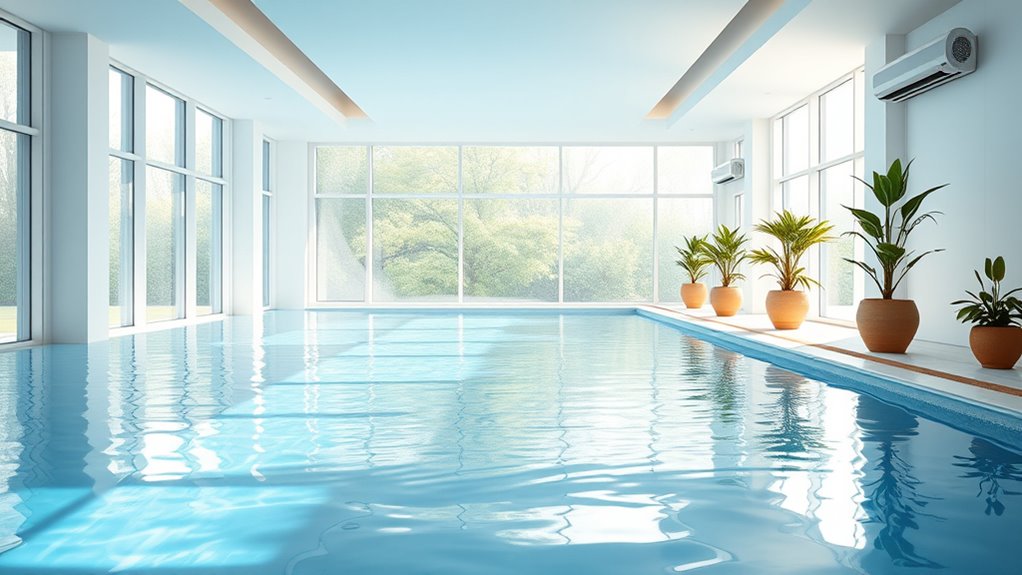
Regular inspections and upkeep of your ventilation system lay the foundation for a healthy indoor pool environment. Beyond maintenance, you can take extra steps to guarantee dryness and safety. Use dehumidifiers to actively remove excess moisture from the air, especially during peak usage times. Maintain proper airflow by opening windows or adding exhaust fans to promote fresh air exchange. Keep an eye on humidity levels with a hygrometer, aiming for 50-60%. Regularly clean and replace filters to prevent mold and bacteria buildup. Additionally, consider these tips:
- Seal any leaks or cracks that allow moist air to escape
- Use moisture-absorbing products like silica gel in storage areas
- Schedule routine professional assessments for your ventilation and dehumidification systems
Implementing these measures helps keep your indoor pool environment dry, safe, and enjoyable.
Frequently Asked Questions
How Often Should I Check My Indoor Pool’s Humidity Levels?
You should check your indoor pool’s humidity levels at least once a week to guarantee ideal air quality and prevent moisture buildup. If you notice excessive condensation, musty odors, or mold growth, increase the frequency of checks. Using a reliable hygrometer helps you monitor humidity accurately. Regular inspections allow you to adjust ventilation and dehumidification systems promptly, keeping your space dry, safe, and comfortable for everyone.
Can Plants Help Reduce Humidity Around Indoor Pools?
Plants can help reduce humidity around indoor pools by absorbing moisture from the air. However, they shouldn’t be your sole solution, as they only handle small amounts of humidity. Incorporate proper ventilation and dehumidifiers to effectively control moisture levels. Choose plants like Boston ferns or peace lilies, which thrive in humid conditions and can contribute to a healthier, more balanced indoor environment around your pool.
What Are the Signs of Poor Ventilation in My Indoor Pool Area?
If you notice a persistent musty smell or visible condensation on windows and walls, poor ventilation is likely. You might also experience foggy mirrors or an increase in mold spots, which are telltale signs your indoor pool area isn’t circulating air effectively. These clues serve as red flags, warning you to improve airflow. Without proper ventilation, humidity builds up, risking damage to your space and health.
Are There Any Natural Ventilation Options for Indoor Pools?
Yes, you can use natural ventilation options for your indoor pool. Open windows and doors regularly to promote airflow, especially during milder weather. Installing operable vents or skylights can also help, allowing fresh air to circulate without mechanical systems. Keep in mind, natural ventilation might need to be supplemented with exhaust fans or dehumidifiers to effectively control humidity and prevent mold growth.
How Do Temperature Fluctuations Affect Indoor Humidity Control?
Temperature fluctuations directly impact your indoor humidity levels, causing moisture to either condense or evaporate. When the temperature drops, humidity rises, increasing the risk of mold and moisture damage. Conversely, higher temperatures can decrease relative humidity, making the air feel dry. You need to maintain a stable temperature with proper heating and ventilation to keep humidity levels balanced, preventing issues and ensuring a safe, dry environment around your indoor pool.
Conclusion
Keeping your indoor endless pool dry and safe is all about balancing humidity and ventilation. Regularly monitor levels, install effective exhaust fans, and use dehumidifiers to stay ahead of moisture buildup. Don’t forget to maintain your systems and guarantee proper air circulation. After all, isn’t your health and safety worth the effort? With the right approach, you can enjoy a pristine, mold-free environment that’s both comfortable and safe for everyone.
